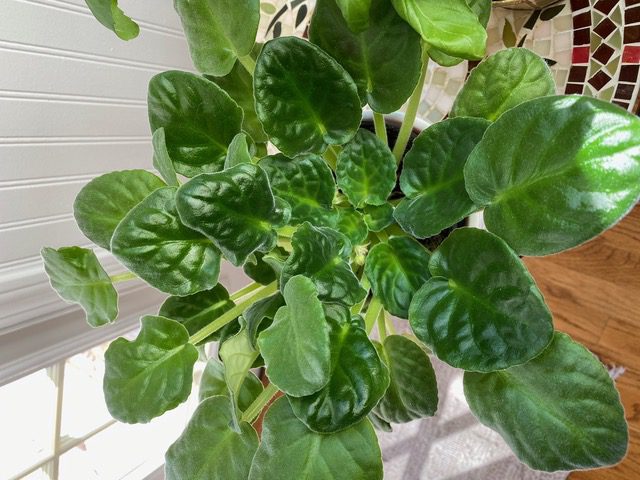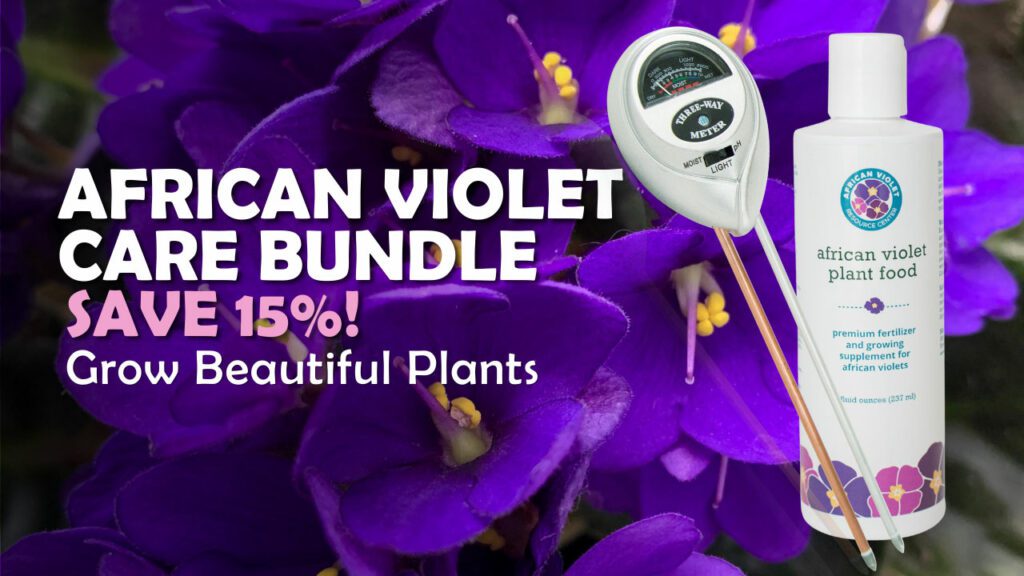It’s a bit of a conundrum: African violets like it a little crowded above ground and below, but they can start to struggle if it gets too tight. In fact, an African violet with too many leaves might even withhold its beautiful blooms—or stop growing altogether!
In this post, we’ll take a look at crowded African violet leaves and how to prune them so your plant can breathe a little easier.
What Causes African Violet Leaf Crowding?
There are a few different causes of African violet leaf crowding. In some cases, suboptimal environmental factors can cause tight crown growth. In other cases, leaves can become clustered and overgrown naturally and will need to be pruned. For both issues, a little TLC should do the trick!
African Violet With Tight Crown
African violets grow from the crown (or top) outward. When something is amiss in your plant’s environment, new growth in the center of the plant is the first to be affected. Sometimes this causes the crown to grow tightly compacted.
Identify this problem by looking at your plant from above: If new growth in the center is ultra-dense and bunched together, you might need to intervene.
Untreated, your plant’s leaves may start to harden and curl in on themselves, and new growth can slow or stop altogether. The good news is, once you correct the environmental issue, they should relax and your plant should pop right back!
What Causes Tight Crowns in African Violets?
- Overfertilization: If your African violet’s crowded leaves look rusty, burnt, or yellow, you may have gone a little heavy-handed on the fertilizer. Flush the soil with room-temperature water several times and hold off on fertilizing for a month. Our guide to African violet fertilizer can help you find the perfect balance.
- Excess light: If your plant’s leaves are drooping down or curling inward and tightly huddling together, it might be getting sunburned! Move the plant to a location with low-filtered light and the crowns should loosen up within a month. Learn more with these tips for African violets and sunlight.
- Excess heat: If your plant’s flowers are streaking, losing color, or dropping altogether, and you notice its leaves curling inward, it could be due to excess heat. African violets prefer steady temperatures around 68ºF; relocate it to a cooler spot and it should bounce right back.
African Violet With Crowded Leaves
African violets produce suckers, or baby offshoot plants growing from the parent plant. This is normal, but it can make your plant look less attractive and prevent blooming if it’s expending too much energy to support its plentiful foliage.
African violets produce new leaves throughout their entire lifetime too. This can cause the plant to be overburdened with foliage growing from the parent plant. In either case, it’s time for a trim! Luckily, African violets are easy to propagate, so you can turn one stressed parent into several beautiful plant babies in both cases.
Pruning African Violet Leaves
To keep your plant healthy, remove three or more bottom leaves every month. This helps make room for new growth and gives the remaining foliage space to stretch out a bit. To free up even more energy, remove any dead or dying flowers during leaf pruning.
Remove older leaves by pinching the stem between your fingers where it connects with the plant base. You may also use sterilized scissors, taking care to remove the stem as close as possible to the plant base without cutting into the parent plant.
If the parent plant is looking extra full but doesn’t have suckers, pinch a few other leaves higher up the base. Moving radially, remove every two to three leaves in each row. Healthy leaves can be propagated after they’re pruned—read on to learn how!
Pruning African Violet Suckers
If your plant has separate crowns or individual suckers, you can break them into new plants while leaving the roots intact. First, remove your plant from its pot. Gently brush away the soil until you’re able to see the individual root systems for each crown or sucker.
Separate the individual plants and place them in a small pot filled with African violet potting mix. You can also place them in a small Ziploc bag to increase humidity and encourage rerooting. In 4-6 months, the sucker plants will grow into beautiful, established plants of their own.
Propagating Leaves Without Roots
Some suckers may be attached directly to the parent plant. In this case, you’ll need a small shear or a sucker plucker to gently scrape the sucker off the stem at a 45-degree angle. Since they’re pruned directly from the plant, these suckers won’t have root systems—give them a helping hand with a propagation booster formulated to encourage rerooting.
Next, place the stem in room-temperature water (but keep the leaves dry!) and in a few months, it will produce new roots and can be transferred to a small pot covered with a Ziploc bag. Inspect your plant every few weeks and moisten the soil if the inside of the bag is bone-dry.
Note: If you are propagating individual leaves, they will grow new plantlets that will ultimately become the newly established plant. The original leaf may die throughout the process, but that doesn’t mean your plant is dying.
New to propagating? Our guide to African violet propagation digs in deep, so you can divide and conquer with confidence!
Have more questions about African violets with crowded leaves? Join the conversation in our Facebook group.
Join the African Violet Club!
Whether you’re just starting or are a seasoned grower, African Violet Resource Center has everything you need to help your plant grow vibrant and strong. Explore our other articles, visit our online shop, and connect with other houseplant lovers in our Facebook group to learn everything you need to know about this rewarding hobby!
More Great African Violet Resources
How Do I Get My African Violet to Bloom Again?
African Violet Plant Care: Do This, Not That!







